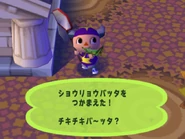- "I caught a long locust! It got the short end of the stick!" —New Leaf
The long locust (ショウリョウバッタ, Shouryoubatta?) is a green bug that can be seen and heard roaming the grass areas of town. It is naturally camouflaged by its green exterior and the green grass that surrounds it. It is easy to locate as its location is betrayed by the sound it makes in flight, but due to its skittish tendencies it can be annoying to catch. It can be found between August to November in Wild World and in Spring and Fall in City Folk, between 8am to 7pm.
Donating to the museum
As with all fish and bugs in the Animal Crossing series series, the long locust can be donated to the Museum. Blathers the curator will say the following in the respected games.
In Animal Crossing
"I have a rather difficult time dealing with the soft underbellies of grasshoppers. They're...vulgar. And their legs! Why do they come off so easily when one merely handles the beast? Blech! Simply horrid!"
In Wild World
"I feel I must inform you the female long locust is much larger than the male. As such, I suspect this one you brought is, in fact, a female specimen. I don't mind telling you, it's not only bigger in size, but in wretchedness, wot? Then again, I suppose the males are quite wretched enough in their own right."
In City Folk
"Female long locusts are a great deal bigger than their male counterparts. Of course, gender aside, these locusts are large in general, hence the name. I must say, regular locusts are rather creepy enough. Being longer simply makes these ones even creepier."
In New Leaf
In New Leaf an information board in the bug exhibit will list information about this bug.
"When male long locusts jump, you can hear the trademark stridulation noise they make. Long locusts can be green as well as brown. The brown ones usually hide near dried grass or brown areas. While males are long, females are consistently much longer, making it simple to tell them apart.
The long locust appears in the first section of the exhibit, past the butterflies and next to the small weed next to the pond.

Long Locust in Animal Crossing.
Capture quotes
- "I caught a longheaded locust! Why the long head? (Face...Whatever.)" —Animal Crossing
- "I caught a long locust! Locust where? Here!" —Wild World
- "I caught a long locust! Long time, no see?!" —City Folk
Encyclopedia information
Wild World
Bug
|
Encyclopedia Information
| |

|
"The male makes a unique clicking sound in flight." | |
| Size | 73 mm | |
| Time | Midday | |
| Season | Fall | |
| Icon | ||
City Folk
Bug
|
Encyclopedia Information
| ||||||||

|
| ||||||||
New Leaf
Bug
|
Encyclopedia Information
| ||||||||

|
| ||||||||
Gallery
Further information
In Japanese, it is called Shouryou-batta which translates to "Spirit Grasshopper". It occurs in two color morphs; green and brown, like many other grasshopper and praying mantis species which creates a situation similar to the european Peppered Moth where only one color flourished in any particular region.
A locust
It eats rice leaves, and many other locust species are widespread pests in large swarms. However, the Long-headed Locust species are not quite so sociable; when more than one is in close proximity it is simply due to a common food source.
In flight the sound it makes is described as "Chiki-chiki", which grants it a second name chiki-chiki batta which unsurprisingly gains many culture references to the TV show Chitty Chitty Bang-bang.

